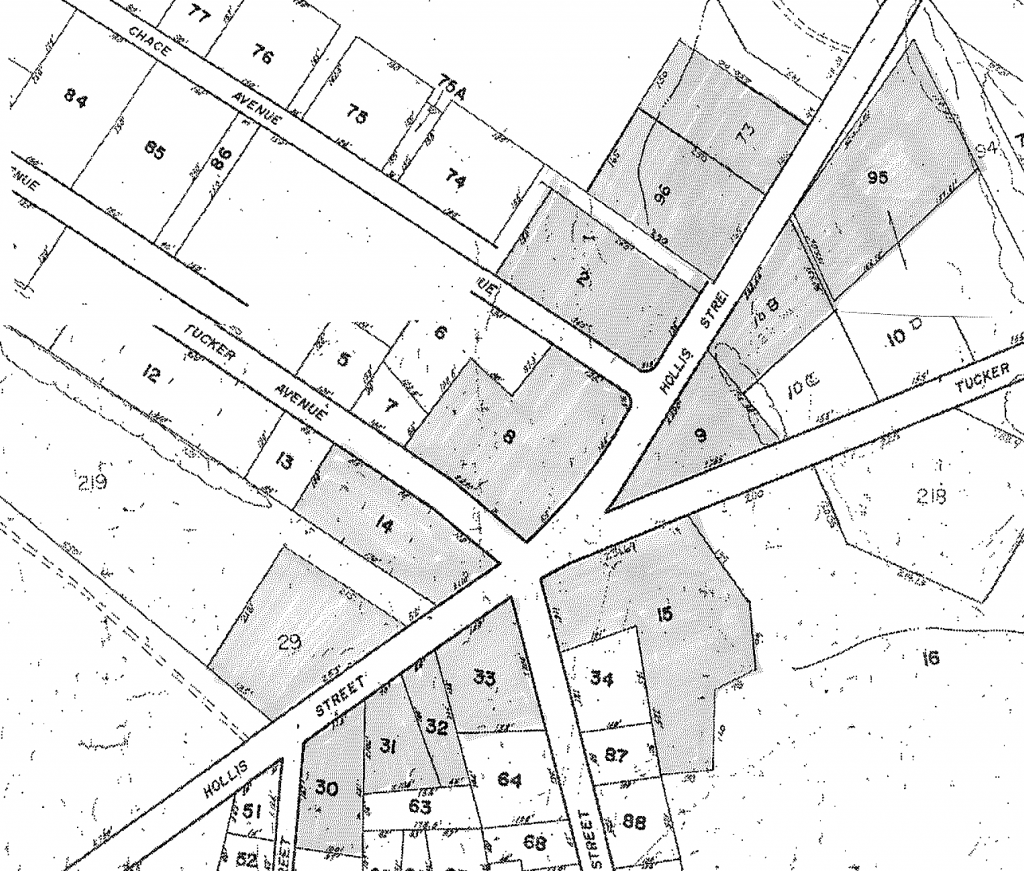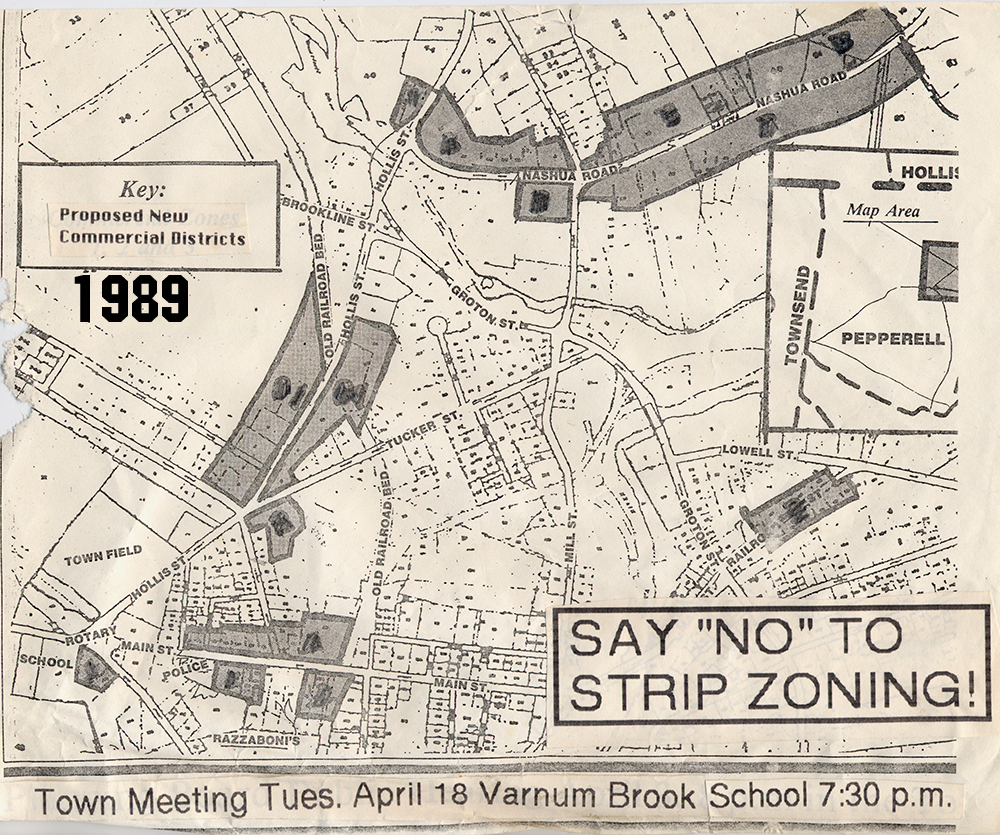Some folks regret that Pepperell has largely avoided the commercial strips that characterize many New England towns such as Dracut, Billerica, and Salem, NH. This is not accidental: Pepperell’s zoning code has protected us from unregulated commercial development by confining new commercial development to a relatively small area of town. It’s not that our zoning law does a very good job of preserving our rural ambiance, but at least we’ve prevented expanding this zone.
On Monday night, March 24, a well-attended Planning Board hearing at the Community Center considered a citizens’ petition to further the expansion of the Commercial District up Hollis Street from the rotary to Clark’s Auto Body and the former Conway Chevrolet property. Not surprisingly, the article is sponsored by Messrs. Clark and Conway, who hope to boost their revenues when they sell their properties. The article will go before the voters at the Annual Town Meeting in May.
Some fourteen properties are involved. At the eastern end of the proposed district are two unquestionably pre-existing commercial properties, the former Conway Chevrolet (owned Dick Conway, who although has never lived here has been quite active the Pepperell business community), and George Clark’s auto body. Next to Clark’s is a day care center which is already permitted under current zoning.
There are only two other commercial properties in the district. Matley’s Plumbing is a very special case, for it combines a preexisting building with a church. Matley built the church in the mid-1980s to house an expansion of his shop, without clearing it first with the town. Whoops! Lucky for him, he found the church, which under the Dover Amendment is a use exempt from zoning. I believe the main building also includes some apartments. (Pepperell zoning law does not allow more than one primary use per lot. Even if rezoned commercial, this property will probably still be non conforming.)
Finally, there’s an assisted living facility adjacent to the driveway to the Varnum Brook Elementary School, which is currently a permitted use. The owners now regard their property as commercial, even though there are no outward signs of this and it is permitted under current zoning. All of the other nine properties in the proposed district (and every lot is occupied) are single or two-family houses. No businesses are evident.
The meeting was surprisingly civil, with the audience more or less evenly divided between proponents and opponents, a division that doesn’t bode well for its passage by a two-thirds vote. The proponents argued that, hey, the proposed district already is commercial anyway, so why don’t we just recognize reality and make things easier for everyone? And the owners are not getting any younger, and they should be able to get the money they deserve when they sell their properties.
The opponents, nearly all of whom live in the affected neighborhood, pointed out the incongruity of commercial activity so close to schools and playgrounds, the unwelcome prospect of increased traffic, noise, and all-night lighting in their neighborhoods, and the fact that the town’s single unlimited commercial zone allows nearly any activity, including fast-food restaurants, all-night convenience stores, and bars. I noted that encouraging commercial development at a five-way intersection of roads that the town, not the state, maintains is crazy.
All this, of course was inspired by last year’s rezoning and subsequent sale of the Bozicas property on Main Street last year at twice its original asking price to the deep-pocketed Southern New England Medical Center, who will shortly be building a major medical center on the 3-acre Main Street property, across the street from Donelans. That change was brought about by citizen’s petition and approved by a vote at town meeting.
Here’s another case of history repeating itself. In 1989 a group of businessmen sought a much larger expansion of the commercial district, from the Rotary up Hollis Street and Nashua Road clear to Lomar Park! This strip zoning proposal caused a political furor that led to my election to the Planning Board and Scott Blackburn (now our Moderator) to the Board of Selectman. At a raucous town meeting the proposal failed on a tie vote (far short of the two-thirds vote it needed).
Now part of the proposal has resurfaced. The driving force behind this new attempt (beside the obvious desire to increase property values) is the alleged need to expand the commercial district, which we’re told needs to be expanded. It has been an article of faith of many in the business community, as well as town officials in their camp, that a shortage of commercial space is holding back the commercial expansion the town so desperately needs to pay its bills.
Despite why you often here, there is no evidence of business being held back by a shortage of commercial space. Quite the contrary. Downtown is littered with “Available” and “For Lease” signs, whether you want space for a store or office, big or small. Clearly, the market is telling us something if we care to listen.
The danger in all this, of course, is whenever a town zones too much property commercial it tends to spread commercial activity over a larger area without increasing the overall volume of commercial sales. Residential properties start to deteriorate, as owners are reluctant to sink money into properties they may be tearing down in the future. Existing business districts, such as Railroad Square, decay. The town looks awful, increasing numbers of residents are affected, and property values decline, wiping out any tax gains.
The applicants seem to have been taken aback by the neighborhood opposition, and when besieged with questions as to why they didn’t confine their proposal to their own properties (Conway and Clark) they muttered something about “spot zoning.” This prompted town attorney Ned Richardson to launch a ten-minute discourse on spot zoning, the gist of which was (we think) that courts tend to defer to the judgment of town meetings. There was talk at the hearing to amend the proposal to exclude all but the easternmost portion (Clark, Conway, and the day care), which has the least opposition since the present use of these three lots is clearly non-residential.
The problem is that even confining rezoning to these three lots would expand the existing free-fire commercial zone and permit almost any conceivable use for the land, from multi-family housing to fast-food restaurant to the most likely outcome—especially for the Conway property—a strip mall/convenience store. Unfortunately, the tenants for this would almost certainly come from businesses currently on Main Street or would replace competing businesses now there. And without architectural review and signage controls the results might be little improvement over the present appearance.
Be sure to attend this year’s annual town meeting on Monday, May 5, 2014. Strip zoning should have no place in our residential neighborhoods, especially one so close to our schools.

